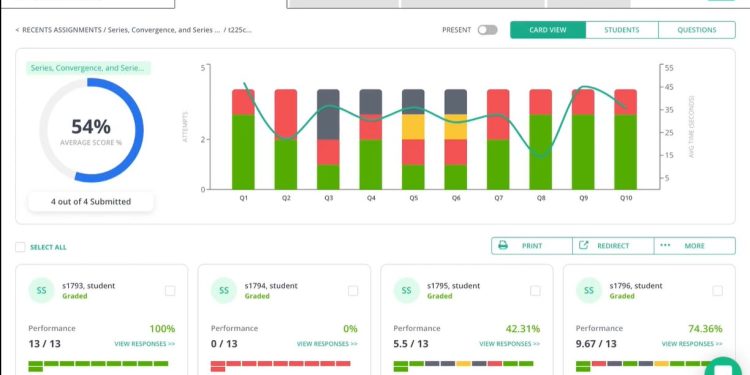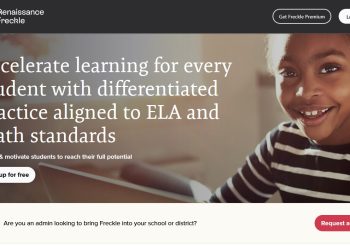Edulastic is an innovative online teaching tool that is revolutionizing classroom assessments and transforming the learning experience for both students and instructors. By leveraging advanced technology, Edulastic provides educators with a digital platform to create, administer, and evaluate assessments in an efficient and effective manner.
With the rise of online teaching, Edulastic has emerged as a game-changer, offering a wide range of features that enhance the assessment process. From interactive learning experiences to alignment with educational standards, Edulastic empowers educators to deliver personalized assessments that drive better educational outcomes.
In this article, we will explore Edulastic in detail, examining its comprehensive overview, its role in the evolution of online teaching tools, and its functionality. We will also discuss the benefits of using Edulastic in education and compare it with alternative tools for classroom assessments. By the end, you will have a deeper understanding of how Edulastic can be utilized to enhance classroom assessments and elevate the learning experience for students.
Key Takeaways:
- Edulastic is an advanced online teaching tool that revolutionizes classroom assessments.
- With Edulastic, educators can create, administer, and evaluate assessments in a digital format.
- Edulastic supports interactive learning experiences and aligns with educational standards.
- The functionality of Edulastic enables educators to create customized assessments and track student progress.
- Using Edulastic provides benefits such as real-time feedback, personalized learning experiences, and data-driven insights for both instructors and students.
Understanding Edulastic: A Comprehensive Overview
In today’s rapidly evolving educational landscape, digital classrooms have become increasingly prominent. With advancements in technology, online teaching tools such as Edulastic have emerged, transforming the way educators assess student learning. This section provides a comprehensive overview of Edulastic, its key features, and functionalities, offering educators a deeper understanding of its capabilities.
The Rise of Digital Classrooms
Digital classrooms have revolutionized the traditional learning environment, offering benefits such as flexibility, accessibility, and personalized instruction. As online teaching becomes more prevalent, educators are leveraging platforms like Edulastic to enhance their classroom assessments and engage students in interactive learning experiences.
Interactive Learning with Edulastic
Edulastic empowers educators to create interactive assessments that go beyond simple multiple-choice questions. With its wide range of question types, such as short answer, essay, and interactive graphs, educators can design assessments that effectively gauge student understanding and promote critical thinking skills. Edulastic also incorporates multimedia elements, allowing educators to embed images, videos, and audio to support the learning experience.
Aligning with Educational Standards
Edulastic recognizes the importance of aligning classroom assessments with educational standards. The platform provides educators with access to a vast bank of pre-created assessments aligned to common core standards and state-specific curriculum guidelines. By using Edulastic, educators can ensure that their assessments are in line with the learning objectives and requirements set by educational authorities.
The Evolution of Online Teaching Tools and Edulastic’s Role
In recent years, there has been a significant evolution in online teaching tools that has reshaped the landscape of education. As traditional classrooms transition into digital spaces, educators have sought innovative solutions to enhance student learning and assessments. Amidst this shift, Edulastic has emerged as a pioneering platform, revolutionizing the way educators assess and evaluate student progress.
The Rise of Digital Classrooms
With the increasing prevalence of technology in education, digital classrooms have become the new norm. Online teaching tools have provided educators with the flexibility to deliver engaging content, tailored to the unique needs of individual students. Edulastic has played a crucial role in this transformation, facilitating seamless transitions from traditional teaching methods to interactive digital experiences.
Interactive Learning with Edulastic
Edulastic offers a range of interactive features that promote active learning and student engagement. Through the platform, educators can create dynamic assessments that incorporate various question types, multimedia elements, and real-time feedback. This interactive learning experience not only captivates students’ attention but also allows educators to gauge their comprehension and provide targeted guidance when needed.
Aligning with Educational Standards
One of the key aspects of effective education is ensuring alignment with established educational standards. Edulastic understands the importance of adhering to curriculum guidelines and provides educators with tools to create assessments that are aligned with these standards. By seamlessly integrating subject-specific standards and learning objectives, Edulastic enables educators to accurately measure students’ proficiency and progress.
As the evolution of online teaching tools continues, Edulastic remains at the forefront of innovation and pedagogical advancements. Through its comprehensive features, interactive learning experiences, and alignment with educational standards, Edulastic empowers educators to create impactful assessments that drive student success.
How Does Edulastic Work? A Closer Look at Functionality
In this section, we will take a closer look at the functionality of Edulastic, the innovative online teaching tool. Educators can utilize Edulastic to create, customize, assign, and track assessments, providing a seamless and efficient way to measure student progress.
To start, educators can create assessments tailored to their specific needs. Edulastic offers a wide range of question types, including multiple-choice, short answer, and essay questions, ensuring versatility and catering to different learning styles and objectives.
Once assessments are created, educators can easily assign them to students. Edulastic enables educators to distribute assessments digitally, eliminating traditional paper-based methods and streamlining the assessment process. This allows for quick and efficient distribution, especially in remote or hybrid learning environments.
As students complete assessments, Edulastic tracks their progress in real-time. Educators can monitor individual student performance and identify areas where additional support may be needed. With this valuable insight, educators can provide targeted feedback and intervention, fostering personalized learning experiences.
Furthermore, Edulastic provides educators with comprehensive data analysis tools. By utilizing these tools, educators can gain deep insights into student performance, identifying trends and patterns. This data-driven approach helps inform instructional decision-making, allowing educators to adapt their teaching strategies to meet the unique needs of their students.
Overall, Edulastic’s functionality empowers educators to create meaningful assessments, efficiently assign them to students, and gain valuable insights into student performance. By leveraging this advanced online teaching tool, educators can enhance the assessment process and ultimately improve educational outcomes.
Examining the Benefits of Using Edulastic in Education
Real-time Feedback and Assessments
One of the key benefits of using Edulastic in education is the ability to provide real-time feedback and assessments to students. With Edulastic, educators can instantly assess student responses and provide immediate feedback, allowing for timely intervention and support. This real-time feedback not only helps students understand their strengths and areas for improvement, but also enables educators to adjust their teaching strategies to better meet the needs of their students.
Personalizing the Learning Experience
Edulastic offers a personalized learning experience for students by adapting to their individual needs and preferences. Through the platform, educators can create customized assessments tailored to specific learning objectives and standards. This allows students to engage with content at their own pace and focus on areas where they require additional practice. By personalizing the learning experience, Edulastic empowers students to take ownership of their education and promotes a more effective and engaging learning environment.
Data-Driven Insights for Instructors and Students
Utilizing Edulastic provides educators and students with valuable data-driven insights. The platform generates detailed reports and analytics, offering instructors a comprehensive understanding of student performance and progress. These insights enable educators to identify trends, patterns, and gaps in understanding, allowing for targeted instruction and intervention. Additionally, Edulastic empowers students to monitor their own growth and development, fostering a sense of accountability and self-reflection.
Edulastic Alternatives: Other Tools for Classroom Assessments
While Edulastic offers an array of features and benefits for classroom assessments, it’s essential for educators to explore alternative tools that align with their specific needs. This section provides an objective comparison of various assessment platforms, highlighting their unique features, user experiences, and pros and cons.
Comparing Features and User Experiences
One alternative to Edulastic is Kahoot!, a widely popular platform that promotes engagement through gamified assessments. Kahoot! allows educators to create interactive quizzes, surveys, and discussions, fostering lively classroom participation and student involvement.
Another option is Formative, which enables formative assessments by providing real-time feedback and progress tracking. With Formative, educators can easily create assignments, quizzes, and tests, while also accessing a vast library of existing educational resources.
Google Forms is a versatile tool that can be utilized for classroom assessments. It offers a user-friendly interface for creating surveys, quizzes, and self-paced assessments. Additionally, Google Forms integrates seamlessly with other Google tools, providing educators with a comprehensive suite of applications.
Pros and Cons of Different Assessment Platforms
When comparing these assessment platforms to Edulastic, there are distinct advantages and disadvantages to consider. While Kahoot! excels in student engagement and interactivity, it may lack the advanced analytics and reporting features found in Edulastic.
Formative, on the other hand, offers excellent formative assessment capabilities, but it may not provide the same level of question variety and customization options as Edulastic.
Google Forms, though widely accessible and user-friendly, may not offer the same level of sophistication in terms of data analysis and assessment customization that Edulastic provides.
Choosing the Right Tool for Your Educational Needs
When selecting an alternative to Edulastic, it’s crucial for educators to consider their specific educational needs and pedagogical goals. Assessments tools should be evaluated based on factors such as ease of use, features, integrations, reporting capabilities, and compatibility with existing systems.
By carefully examining the strengths and limitations of each tool, educators can make an informed decision that best aligns with their classroom requirements and objectives.
Conclusion
In conclusion, Edulastic is an exceptional online teaching tool that brings a new level of innovation and efficiency to classroom assessments. By embracing the advanced features and functionalities of Edulastic, educators can optimize the learning experience for their students and drive improved educational outcomes.
Throughout this article, we have explored the comprehensive overview of Edulastic, its role in digital classrooms, and its alignment with educational standards. We have also discussed how Edulastic works, providing a closer look at its functionality and various question types it supports.
Furthermore, we have examined the numerous benefits of using Edulastic in education, such as real-time feedback and assessments, personalized learning experiences, and data-driven insights for instructors and students. These benefits empower educators to make informed decisions, tailor instruction to individual needs, and enhance student engagement and success.
In a market full of assessment platforms, Edulastic stands out as a powerful tool that enables educators to create dynamic assessments, track student progress, and analyze data effectively. By utilizing Edulastic, educators can enhance classroom assessments, foster a more engaging learning environment, and ultimately support student growth and achievement.
FAQ
How does Edulastic work?
Edulastic is an online teaching tool that allows educators to create, administer, and evaluate assessments in a digital format. Teachers can create and customize assessments, assign them to students, and track their progress. Edulastic supports various question types, including multiple choice, short answer, and essay questions.
What are the benefits of using Edulastic in education?
Edulastic offers numerous benefits for educators and students. It provides real-time feedback and assessments, enabling teachers to identify areas where students may need additional support. Edulastic also personalizes the learning experience for students, adapting to their individual needs and preferences. Additionally, the platform provides data-driven insights for both instructors and students, facilitating informed decision-making and targeted instruction.
Are there alternatives to Edulastic for classroom assessments?
Yes, there are alternative tools available for classroom assessments. Educators can explore different assessment platforms and compare features and user experiences. It is important to consider the pros and cons of each tool and choose the one that best suits their specific educational needs.






